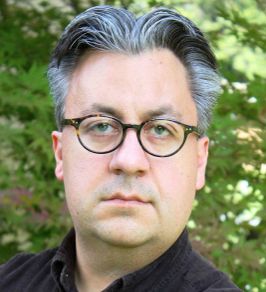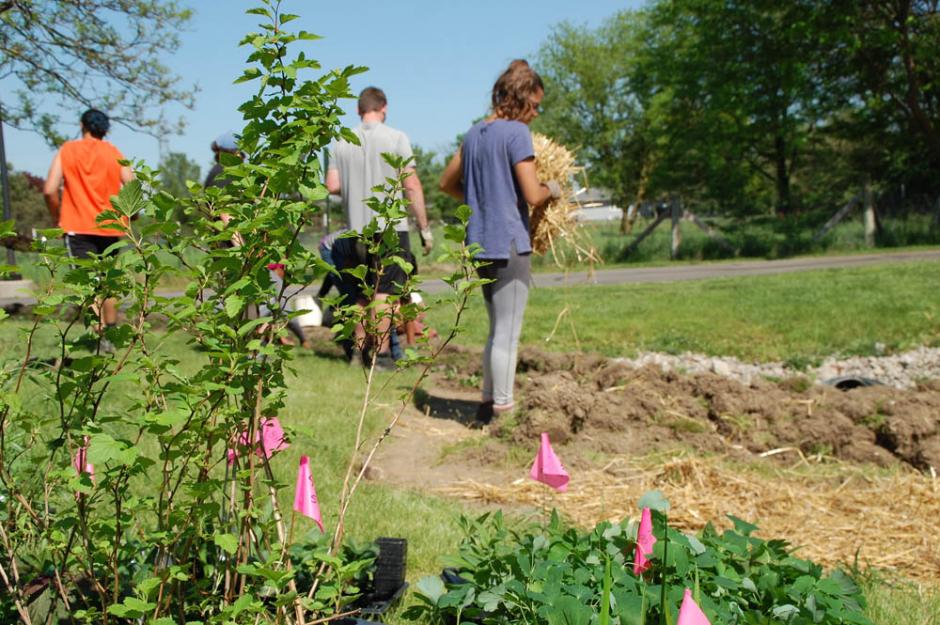
Students from Siena Heights and Barry Universities plant a rain garden in the Adrian Dominicans' permaculture gardens as part of the Environmental Leadership Education program. The garden catches rainwater runoff from a parking lot, filters it and allows it to soak into the soil. (Courtesy of the Adrian Dominicans/Ashley LeVigne)
It’s easy to become alarmed and overwhelmed by news about the environment. It is impossible to avoid images of melting glaciers, overflowing landfills, and creatures – animals and humans alike – on the move because of climate change. It's difficult to maintain hope in times like these. On your own or with a partner, consider:
- How do concerns about the environment affect your everyday actions? For example, do you use a refillable container for drinking water? Do you shut off lights when you leave a room? Do you arrange carpools or use public transportation? What concerns you, and how do you respond?
- Where, if anywhere, do you find hope that people can make a difference in stopping or reversing environmental degradation?
There are nearly 8 billion people on this planet, and that number grows every day. This alone could be cause for concern. Consider the hope and creative ideas generated by the relatively few people in this article. Can you imagine yourself joining their efforts?
Congregations seek sustainability through goals to reduce waste, go organic
by Dan Stockman
Editor's note: Women religious have long been dedicated to caring for the Earth. As the 24th U.N. Climate Change Conference in Katowice, Poland, gets under way Dec. 2-14, this story looks at the efforts of three congregations, each focused not just on protecting the environment, but ensuring their uses within the environment are sustainable.
When the Sisters of Charity of Nazareth, Kentucky, updated their mission statement in 1995, they decided at the last minute to add six words to the end: "and to care for the Earth."
An afterthought at the time, those six words have become integral to everything the international congregation does.
As the years passed and asking that question became part of everyday life, the sisters realized they often didn't know the answer. Or when they thought they knew the answer, they feared it might be incomplete or based on assumptions rather than evidence: Electric vehicles seem like a good alternative, but might not be if your electricity comes from burning fossil fuels.
"We really take that seriously," said Sr. Susan Gatz. "We began asking ourselves on every level: How are we helping or hurting the Earth?"
"If you want to help the Earth instead of hurt it, the question becomes, 'So how do we do it?'" Gatz said. "We wanted to look at everything — water, electricity, recycling."
Sisters have been working to protect the environment and teaching others to protect it for decades. In recent years, many communities have worked to permanently protect their own land holdings from development.
But in 2014, the Sisters of Charity of Nazareth realized they wanted to take their efforts further. They also knew they would eventually need to make decisions about the land and buildings they own: the motherhouse campus that was once home to hundreds of sisters, Nazareth College and Academy, the infirmary, the novitiate and a large working farm. What should the land and buildings be in the future, and, more importantly, how could they be used to help care for the Earth?
"We've done some really good things, but we realized we wanted to go to the next level," Gatz said. "We needed someone in the community whose focus was only that."
Carolyn Cromer was named director of the sisters' Office of Ecological Sustainability in 2017. She got right to work: Within a few months, she had set a goal for the congregation's Western Province (the United States and Belize) to become greenhouse-emissions free by 2037 and the Eastern Province (India, Nepal and Botswana) to do the same by 2047.
"That goal is in no way extreme," Cromer said. "But we wanted to set that goal, because if not us, then who?"
There are also opportunities in areas that might be surprising. The congregation's Eastern Province has an extra 10 years to meet its goal of zero greenhouse emissions, but it may meet its goal before the Western Province.
Where the sisters minister in India, Nepal and Botswana, there is often little or no infrastructure, so it is not only easier to start out using sustainable energy such as solar power than it is to convert, but sometimes, the sustainable method is the only one available, Cromer said. You can't connect to the grid if there is no grid to connect to.
Recently, Cromer recruited some sisters to examine every piece of waste the campus generated in one day so sisters and staffers could understand the amount of waste created and to see what is being treated as waste that could be reused or recycled.
Cromer has also helped the community to examine its use of fossil fuel-burning vehicles.
"The care committee took a good, long look at the number of miles we drive," Cromer said. "The emissions are significant. So we're purchasing one or two electric vehicles this year."
And because burning fossil fuels generates almost two-thirds of the electricity in the United States, negating much of the environmental benefit of electric cars, the community hopes to eventually have a solar-powered charging station for the new electric vehicles.
Cromer, who has degrees in both ecology and forestry, said a lot of the questions in sustainability don't have easy answers. The motherhouse campus, for example, has been farmed and landscaped and manipulated for more than a century, so returning it to its natural state is not as simple as not mowing the grass.
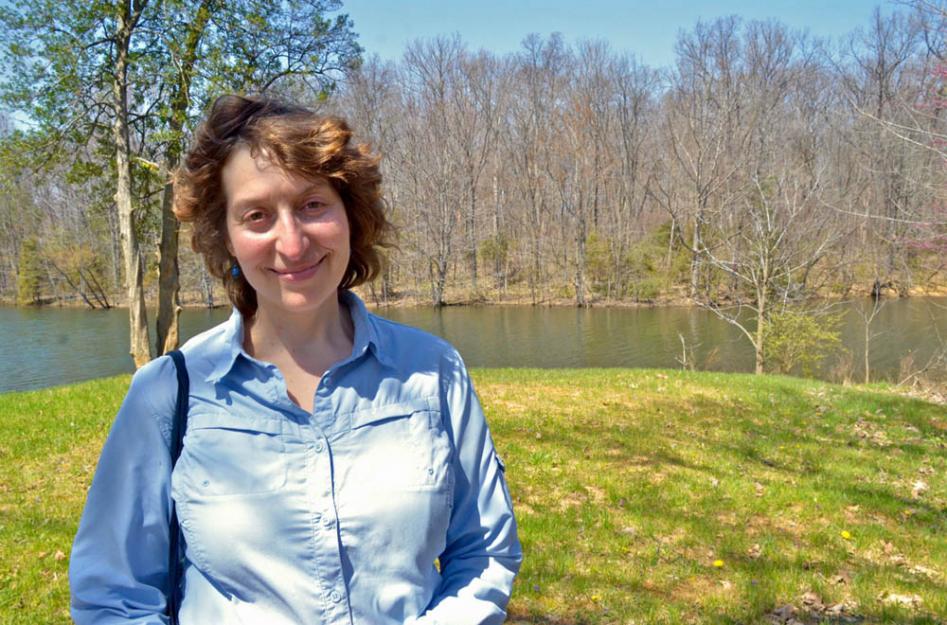
Carolyn Cromer, director of the Sisters of Charity of Nazareth's Office of Ecological Sustainability, discusses the order's efforts to protect the environment at its motherhouse in Nazareth, Kentucky. (GSR photo / Dan Stockman)
Having Cromer on staff has turned even simple projects into researched changes. When some vinyl flooring needed to be replaced in one of the buildings, the sisters
planned to install carpet until Cromer pointed out that carpet can emit chemicals into the air for years. Instead, the floor was painted with low-emission paint.
"Nazareth isn't its own little thing," she said. "We sit in a watershed and in a region, and all of it is interconnected. So we can't be planning in isolation."
Change through permaculture lens
Planning has also been key for the Adrian Dominican Sisters, who have been practicing permaculture since 2012. Permaculture is a strategy to work in harmony with the land rather than trying to fight the forces of nature.
Sr. Corinne Sanders, the congregation's director of sustainability, said permaculture — a combination of the words "permanent" and "agriculture" — is at its heart a design principle, but it has become part of the community's culture, as well.
"Many look at permaculture as agricultural or that it's only for land-based applications, but it applies to all aspects," Sanders said. "It's everything from how buildings come into being to the health and spiritual well-being of the people living and working there."
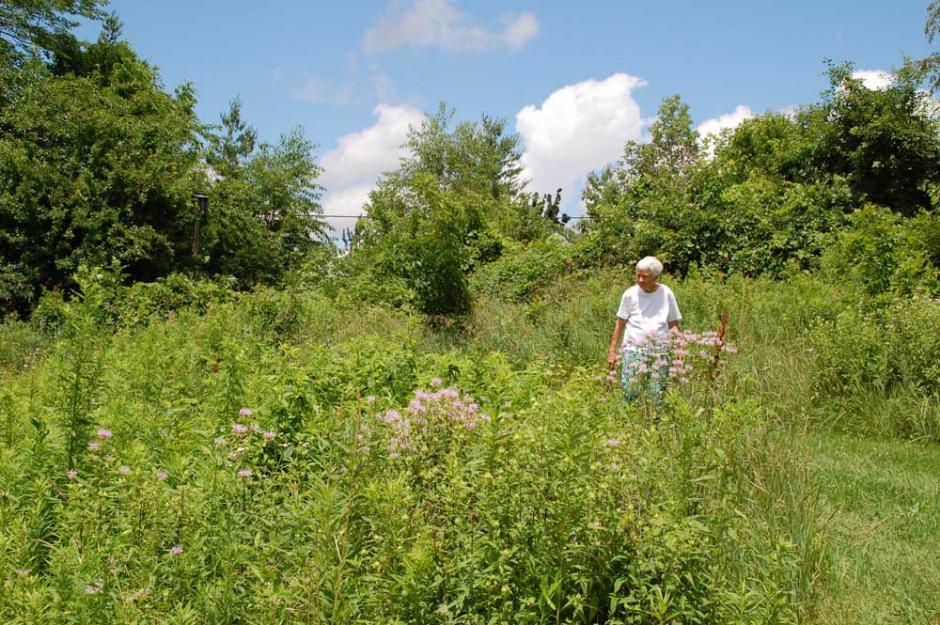
Adrian Dominican Sr. Carol Coston walks through the community's permaculture site, which is designed to put agriculture in harmony with nature, rather than fighting it. (Courtesy of the Adrian Dominicans)
The most obvious aspect of the community's efforts is the Permaculture Gardens, which were once seven acres of mowed turf grass but now feature a food forest; four different types of composting; a community garden; a garden in raised beds on permeable asphalt so it is accessible to those using wheelchairs, walkers or scooters; a vegetable cooperative; rainwater-harvesting structures to irrigate the gardens; and earthworks and swales to slow, spread and filter rainwater runoff.
"Permaculture has been around for a long time," Sanders said. "It's really a design principle for working with and in harmony with nature, so it's based on three ethics: Earth care, people care and fair share."
Now, any type of building renovation, upgrade or construction project for the Adrian Dominicans is looked at through the permaculture lens, she said, with the goal of producing no waste and using as little energy as efficiently as possible.
"We've made a commitment to look at our own lifestyles and our impact on climate change and degradation of the Earth, and we look at permaculture principles as guiding ways to do that," Sanders said.
Next door to the motherhouse campus is Siena Heights University, which the congregation sponsors. In addition to the students and faculty who volunteer at the permaculture site, classes meet there once a week for on-site learning.
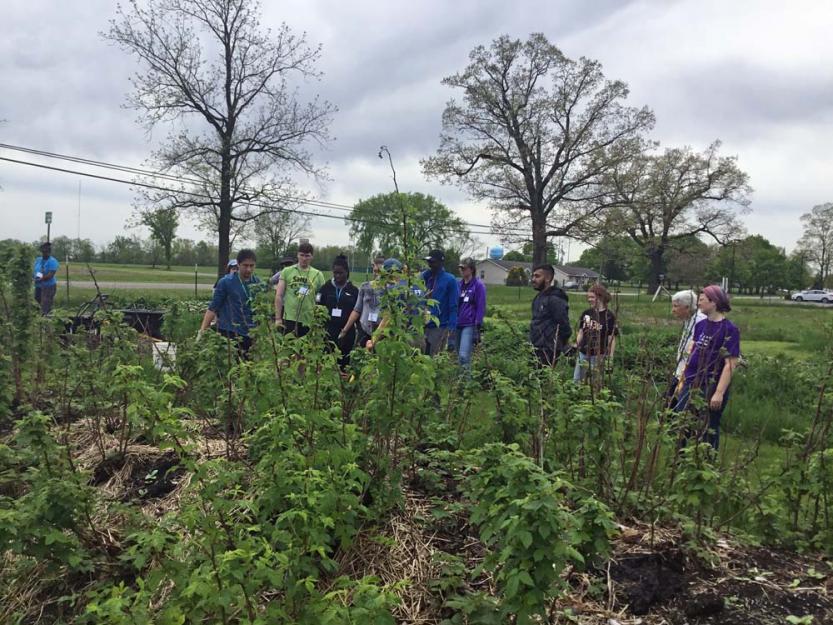
Students from Sienna Heights and Barry Universities work on hugel mounds in the Adrian Dominicans' permaculture gardens as part of the Environmental Leadership Education program. Hugel mounds use decaying wood debris and other compost is used to create a raised bed for planting. (Courtesy of the Adrian Dominicans / Ashley LeVigne)
The congregation also sponsors Barry University in Miami Shores, Florida, and students from Barry and Siena Heights come together for two weeks of intensive permaculture education at the site. The sisters hope to soon have a permaculture site at Barry and do another two-week program there, focusing on the endangered ecosystems and agriculture of that area.
"For years, we've been so involved in our relationship with Earth, but now the need is so imminent right before our eyes," Sanders said. "Permaculture goes beyond just agriculture."
Land brings 'abundant life'
The Villa Farm at the Sisters of the Humility of Mary campus in New Bedford, Pennsylvania, has been sustaining the sisters and their neighbors since 1864. Land manager John Moreira's job is to make sure it can do so for the next 154 years.
"There's an old adage that goes back to the Dust Bowl," Moreira said. "If you're not trying to grow your soil, you'll lose your soil."
Moreira said continually planting row crops without proper cover and without allowing the land to go fallow occasionally doesn't just deplete the nutrients from the soil, it depletes the soil itself.
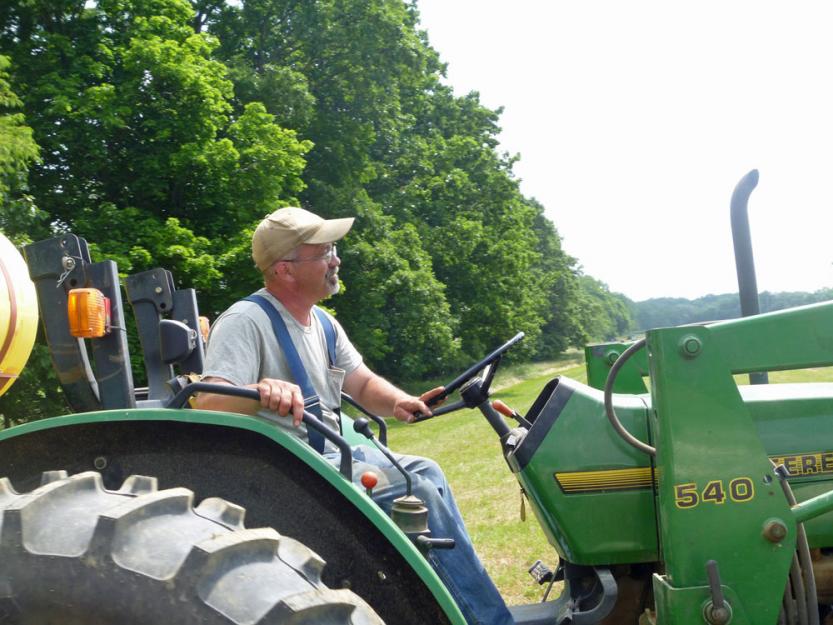
John Moreira, director of land management at Villa Maria Farm, takes the tractor out to one of the farm's many fields. (Courtesy of Sisters of the Humility of Mary)
"You do corn after corn after corn, and there's a demonstrable difference in the soil that's there," he said. "But you can make organic matter just by proper crop rotations and fallow years."
But that dedication requires a long-term view, rather than a constant quest for short-term profits. Last week, Moreira said, the farm across the street harvested its crop of soybeans, but the Villa Farm waited, because the soil was too wet and would be compacted by the tractor, causing permanent damage. The result was a less-than-stellar harvest, but soil that remains healthy.
That long-term vision has led the sisters to go through the multi-year process of having the farm certified as organic. One hundred fifty of the farm's 280 acres should be certified organic next year, and the rest should be certified the year after. Once the crops are certified, Moreira said, they will double and sometimes triple in value.
"There's a demand for it in the United States," he said. "We're importing organic food from Europe because farmers here can't meet the demand."
"Our mission is to bring more abundant life to God's people, especially the poor," said Sr. Barbara Wincik. "The land is very important to that."
While the row crops are sold, much of the produce is donated to food banks.
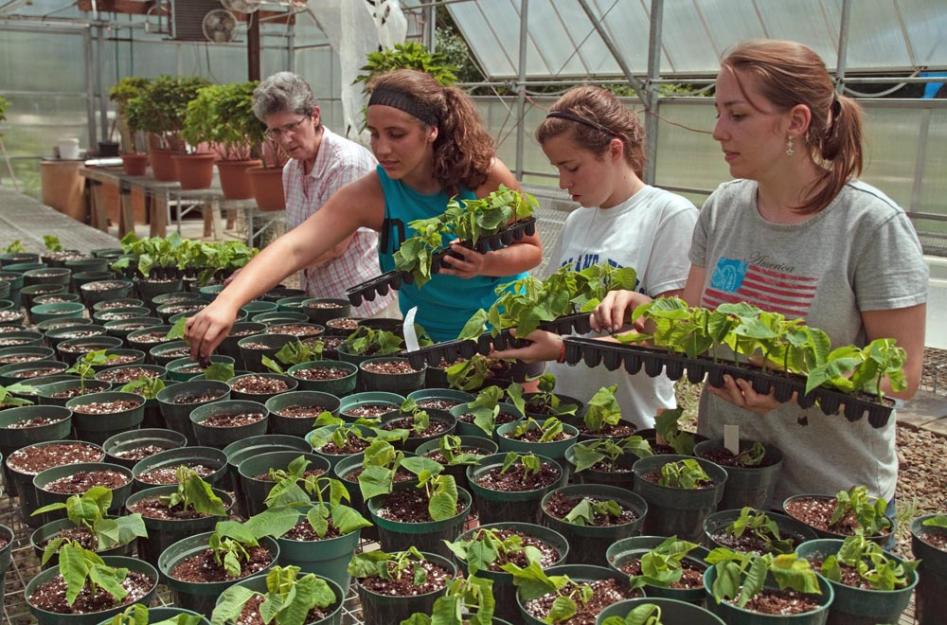
Humility of Mary Sr. Linda Valasik, left, supervises some volunteers replanting vegetable starts in the Villa Maria Farm Greenhouse. (Courtesy of Sisters of the Humility of Mary)
Wincik said the farm may be sustainable agriculturally and ecologically, but is not currently self-sustaining economically. That may change once it has organic certification.
The 759-acre campus also has 400 acres of forest that are carefully managed.
Wincik said the harmony with the land extends beyond sustainability efforts — the sisters have been living, praying, working and ministering on the land for a century and a half, and that spirituality can be felt. She said visitors to the campus retreat and education center remark that when they drive onto the property, they immediately feel a sense of peace.
"I think that's what people feel when they come to the Villa," she said. "It's just peaceful."
Consider the sisters' focus on whether the way they live helps or hurts the Earth.
- How would your life change if you based your choices and actions on this concept?
- What would be hard about this? What would you have to sacrifice?
- What would be positive about this? What change in your life would you look forward to making?
John the Baptist sent some of his followers to discover what Jesus was all about. Jesus tells them to share this hopeful news:
"Go and tell John what you have seen and heard: the blind regain their sight, the lame walk, lepers are cleansed, the deaf hear, the dead are raised, the poor have the good news proclaimed to them."
- Jesus is talking about how he has responded to some seemingly hopeless situations. What can we discover about Jesus and his concerns in these words?
- What do Jesus' efforts have in common? Which do you find most remarkable?
- How might Jesus respond to the needs of the planet? What are his followers called to do?
In Laudato Si’, his encyclical on care for the Earth, Pope Francis writes:
"In some countries, there are positive examples of environmental improvement: rivers, polluted for decades, have been cleaned up; native woodlands have been restored; landscapes have been beautified thanks to environmental renewal projects; beautiful buildings have been erected; advances have been made in the production of non-polluting energy and in the improvement of public transportation. These achievements do not solve global problems, but they do show that men and women are still capable of intervening positively. For all our limitations, gestures of generosity, solidarity and care cannot but well up within us, since we were made for love."
"Laudato Si’: On Care for Our Common Home" [58]
- What common trait and which common ability do Pope Francis see among the people who share this common home?
- Do efforts like those mentioned in the article and those cited by Pope Francis carry the same weight as those Jesus shares in the scripture passage? Why or why not?
The Villa Farm is just one way that sisters help people connect with creation. They raise, donate and sell organic produce. People also can get their hands dirty by volunteering on the farm. Explore whether your school or church is open to devoting some of its land (even installing raised garden beds on a parking lot) to raise food for its own use or to donate to neighbors in need. Also look into the availability and costs of Community Supported Agriculture in your area and see whether locally grown produce can be used in your cafeteria or for parish events.
Try the following exercise, similar to what the sisters in the article did:
- Brainstorm a list of every waste item you generate every day. Include items like sandwich wrappers, toilet paper, plastic water bottles, disposable utensils and drinking straws. Include notes about where each item eventually winds up (recycling, landfill, sewage plant, etc.).
- Keep a journal for one day of your actual waste generation and where things wound up. Compare it to your original list.
- Ask the following questions:
- Am I surprised by how much waste I generate?
- Did keeping the journal change my practices that day? Was I less wasteful?
- What changes can I make to generate less waste in my daily life? What are three I can commit to right now?
God of all creation, giver of gifts great and small,
thank you for the vast blessing of the common home we call Earth.
Stir us with amazement and amusement, with shock and sorrow, for the wonders and woes to be found throughout the land, sea and sky.
Let us not slip into despair, but lift us up to to be good stewards of our common home.
And let us not be blind to the gifts of those who share this home and the fortitude we find when we work together to protect and heal your creation.
Amen.
Tell us what you think about this resource, or give us ideas for other resources you'd like to see, by contacting us at education@globalsistersreport.org.
